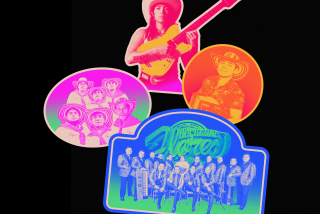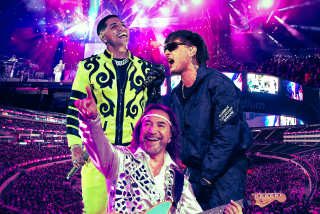A long-term extravagance
At the new Conga Room -- call it Version 2.0 -- the guiding philosophy seems to be the opposite of Ludwig Mies van der Rohe’s famous dictum that “less is more.” At the revamped, relocated incarnation of the popular Wilshire Boulevard Latin music venue that went dark 2 1/2 years ago, the owners are hoping that more will be more.
“My kids are growing up. I just turned 47. So if not now, when?” said club founder and principal owner Brad Gluckstein, explaining what inspired him and a co-owners group that includes Jimmy Smits, Jennifer Lopez and Clippers guard Baron Davis to reopen a bigger, splashier Conga Room across from Staples Center in downtown L.A.
“This is a legacy project, not just for my family but for the city,” said Gluckstein, a native Angeleno, real-estate developer and self-described “inherently Jewish” guy “with a corazon Latino” (Latino heart).
It’s a high-profile gambit that could tap into the synergistic energy surrounding the neighboring Nokia Theatre and the rest of the massive, $2.5-billion L.A. Live complex as well as the just-opened Grammy Museum around the corner -- or fall flat in the current southbound economy. That would be an embarrassing blow to AEG, the Los Angeles development company run by billionaire Philip Anschutz that controls L.A. Live and has an exclusive talent-booking deal with the Conga Room.
But Gluckstein’s big words are not without basis. The old Conga Room, squirreled away in a former health spa, served as a prototype for the new club. But the difference in scale and ambition between the venues is roughly akin to the difference between Kool-Aid and a caipirinha.
For starters, the new club, with 15,000 square feet and a capacity of about 1,000, is nearly three times the size of the funky, elbow-bumping old club. (Basic cover charge for the new venue ranges from $18 to $25.) Gluckstein said the concept for the Conga Room “outgrew” its old location, which was hampered by poor freeway access and by being on the edge of a primarily residential neighborhood.
When the new Conga Room officially opens Wednesday evening, long-time patrons also might be surprised by the expanded musical menu. The offerings naturally will include heaping portions of salsa and merengue, the club’s signature sound. But there also will be a tapas bar’s worth of World Beat, tropical, rock en Espanol, jazz, mariachi, Brazilian and alternative Latin sounds, all under the guidance of the Conga Room’s newly appointed musical director Oscar Hernandez, leader of the Spanish Harlem Orchestra and collaborator with the likes of Paul Simon and Ruben Blades.
Hernandez will direct the club’s house band, hand-picked, crack musicians who Hernandez vows will be not only danceable but as listenable as any concert-hall ensemble. “My vision is to basically create the perception that this is an elite team, this is an elite ensemble of musicians.”
Hernandez, who moved to Los Angeles from New York two years ago, said he’s grateful to have the chance to “put a stamp on the West Coast” and bring to Los Angeles audiences “some hard-core, real-deal salsa.” One key challenge for the club’s owners, he believes, will be to create a congenial space that’s equally accommodating to the hoi polloi burning up the dance floor and the velvet-rope crowd stashed away in Barcelona chairs sipping cocktails in the VIP lounge.
Many influences
Between its February 1998 opening and the start of its hiatus in May 2006, the old Conga Room gradually had evolved from primarily a salsa dance spot to a pan-Latin and world music venue. Accordingly, the new club’s interior design is meant to mirror that pan-Latin/global sensibility.
“This is a really hybrid space up here,” Gluckstein said. “Philippe Starck we’re not.”
From its perch on a noisy, light-swept public plaza where on any given night there could be thousands of Lakers, Clippers or Kings fans plus mobs of concert-goers and tourists milling around, the Conga Room also must strive to maintain an atmosphere that’s both intimately human-scale and cosmopolitan. “It’s a deliberate balance to really keep it elegant and sophisticated in a setting that would want you to be more like a sports bar,” Gluckstein said.
Architect Hagy Belzberg said that his idea was to take a number of Latin American design motifs, gleaned from the Caribbean to Buenos Aires, and “create an iconic experience.” The acoustically engineered ceiling, made up of two-paneled sections that resemble white footprints, is an abstraction of a triangular salsa dance-step diagram. The floral-looking wall pattern behind the club’s main bar is a stylized butterfly, repeated over and over like a musical refrain.
Belzberg, who moved to Los Angeles from Israel as a child, said that the club’s design echoes the growing Latinization of Southern California and the way that different Latin cultures are being woven into the regional fabric. “We are the environment,” he said. “It is a constant part of our lives.”
The club’s artworks offer a similarly eclectic, pan-Latin lineup of tastes and styles. For a decorative centerpiece, Gluckstein commissioned the Papaya Bar, a massive stand-alone drink station made of undulating yellow metal by the L.A.-based Cuban American artist Jorge Pardo. The bar, suggesting a split-open papaya, is strongly reminiscent of Pardo’s wavy sculptural display cases recently installed in the Los Angeles County Museum of Art to house its pre-Columbian collections.
Walls, columns and other locales throughout the club have been tattooed with pop-folkloric stencils and murals by artist-musician-filmmaker Sergio Arau, best known for the hit comedy-satire “A Day Without a Mexican.” Arau even plans to graffiti the doors of the women’s lavatory stalls.
He’s also making what he calls “a digital mural,” a series of partly animated video projections that reinterpret classic Latin American iconography: angels, lucha libre wrestlers, Aztec ballgames and so on. “It’s like a moving painting,” he said.
Arau refers to the aesthetic sensibility of his imagery as “not Art Nouveau” or “Art Deco” but “Art Naco,” a wordplay on a colloquial Mexican term for something that’s so tacky, it’s cool. “It’s really a baroque place,” Arau said of the Conga Room. “It’s equivalent to the way we talk. Latinos are loud -- well, this is loud!”
Other selling points
Just as high-fashion threads make the status-conscious man or woman, music and design are what give a nightclub its primary identity. But the Conga Room hopes to lure patrons with two other elements. One is the kitchen, often an afterthought at many clubs.
Chef Alex Garcia, a pioneer of Nueva Latina cuisine, promises to replicate the classics -- arroz con pollo, churrasco grilled meat, green plantain fritters -- while also inventing new dishes infused with culinary tips he absorbed from his Cuban grandmother. “We’re trying to do a menu where everybody’s going to feel included,” he said. “It’s really a nostalgia corner for every Latin American person around.”
The other selling point is the club’s in-house, state-of-the-art broadcasting and recording studios, which will allow for live recordings, webcasts and telecasts that capture the action on the 576-square-foot center stage. Co-owner Smits said this new capacity and the close proximity of other broadcast entities, such as ESPN’s new regional broadcast center next door, will help the Conga Room soak up energy off the adjoining open-air plaza. “You really get that big Times Square kind of vibe,” he said.
Of course, opening an upscale nightclub at a time when millions of Americans are feeling inclined to curb entertainment budgets is not without risk. Gluckstein, however, remains confident that the club’s brand name, careful financial planning and reliable business partners like AEG will see it through tough times.
Plus, he said, if the Lakers win a championship, for instance, and the Conga Room’s neighbors throw special-events business its way, the club could reap additional windfall. “We’re larger than a restaurant, and we’re smaller and more organic than a theater,” he said. “I think we hit that perfect sweet spot in the district that would be very attractive to party and event planners.”
Being inside the global entertainment fishbowl is a definite change of scenery for the little Miracle Mile nightspot that Cuban salsa singer Celia Cruz helped christen, and where Gluckstein himself was married many years ago. But if Gluckstein’s buoyant attitude is any indication, the Conga Room is ready for its close-up.
“The first thing I would say,” he said, smiling as he glanced out at Staples Center’s glowing facade, “I love my real estate.”
--
More to Read
The biggest entertainment stories
Get our big stories about Hollywood, film, television, music, arts, culture and more right in your inbox as soon as they publish.
You may occasionally receive promotional content from the Los Angeles Times.











